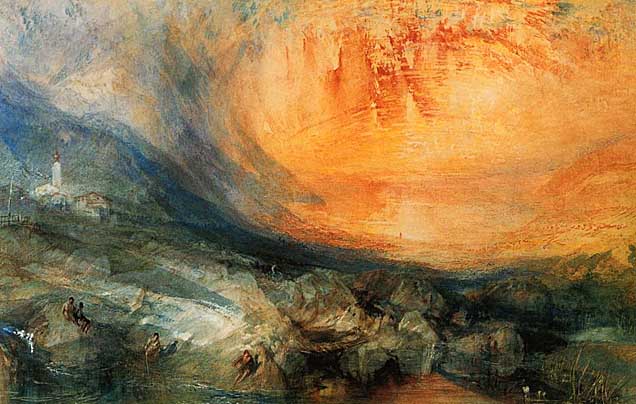AMNA NAWAZ: British painter JMW Turner was both prolific and wide-ranging in his work. He traveled throughout England and Europe, often with a small watercolor case at his side. Now a rare show of watercolors Turner made throughout his career is on view at the Mystic Seaport Museum in Connecticut through February. And it's the only North American stop these fragile works will make. Special correspondent Jared Bowen has our report. It's part of our weekly series on arts and culture, Canvas.
JARED BOWEN: JMW Turner moved from cathedrals to coasts, from the bright light of day to the deep dark of night, and from the moody tones of his native England to the luminescent glow of Venice, Italy. For the famed painter, they were wanders in watercolor.
DAVID BLAYNEY BROWN, Senior Curator, Tate Britain: I think some of his most original and expressive and experimental, groundbreaking work was actually in watercolor on paper.
JARED BOWEN: That medium is where his ideas formed and flourished with a fervor. Starting with the first watercolor he painted of this gorge at age 17, Turner painted more than 30,000 in his lifetime.
DAVID BLAYNEY BROWN: Drawing and, indeed, painting in watercolor was almost a compulsion. It was like a kind of a nervous tick. He just wasn't comfortable unless he was doing it.
JARED BOWEN: Turner scholar David Blayney Brown is a senior curator with Tate Britain, the London museum that holds the Turner bequest, a collection of tens of thousands of works, including these watercolors, that went to the museum after his death in 1851.
DAVID BLAYNEY BROWN: He certainly had a high opinion of himself. He wasn't a modest man. He realized that he was a great artist, and he wanted to leave a legacy to the nation, to the British nation.
JARED BOWEN: Now that legacy is getting some international burnishing. The watercolors, which are extremely susceptible to light damage, can only be shown once in a generation. After stops in Italy and Argentina, the show is making its only North American appearance at Connecticut's Mystic Seaport Museum.

STEVE WHITE, President and CEO, Mystic Seaport Museum: This is the most significant exhibition, I believe, that we have had in our 90-year existence.
JARED BOWEN: So significant that, five years ago, when the museum was building this new facility, its president, Steve White, says he told the architectural team:
STEVE WHITE: The conditions and the specs for the space have to be good enough for Turner, because that's the, that, for us, would be the most defining exhibition.
JARED BOWEN: So this, says White, is a dream come true, to marry Turner's lifelong interest in maritime painting with the Mystic River flowing just outside.
STEVE WHITE: This exhibition, because of Turner, because of his expression of the sea, his expression of landscapes, he brings the spirit of this place alive in a much different way.
JARED BOWEN: Do we have a sense of how he's working with movement here, or is it strictly, do you think, about color?
DAVID BLAYNEY BROWN: I think it's about movement as well, because the color has to move, doesn't it? I mean, this is a coastline. There's a storm approaching. The clouds are presumably moving quite fast. And the waves are crashing on the beach.
JARED BOWEN: Five years ago, in 2014, the Mike Leigh biopic Mr. Turner painted the artist as a frenzied storm of creativity.
DAVID BLAYNEY BROWN: That film was a movie, is what I will say.
JARED BOWEN: In truth, David Blayney Brown says, Turner was likely much more methodical.
DAVID BLAYNEY BROWN: He must have worked with great care and great precision, certainly in some of the images in this exhibition. They're extraordinarily finely worked. Some are minutely detailed. And instead of broad, sweeping surges of paint, there are just tiny little dots, you know, laid onto the paper, almost like setting tiny diamonds into a ring.
JARED BOWEN: While many of Turner's works appear ethereal and idealized, he was also fond of what art critics and historians have come to describe as litter, the little figures, animals and general stuff that frequently dot his foregrounds.
DAVID BLAYNEY BROWN: They can look very untidy. But, of course, the real world is often an untidy place. He wants to root things in reality.
JARED BOWEN: As an inveterate traveler, his work changed as often as his landscapes did, especially in Venice. The work he produced during his third and final trip there in 1840 prompted one critic to proclaim Turner a magician, with command over the spirits of earth, air, fire, and water.
DAVID BLAYNEY BROWN: The real thrill of Venice for him was probably the fact that it has this extraordinary aqueous light. For an artist who's very interested in luminous effects and how to bring light into pictures, the effect the light has and the way it seems to merge the sea and the sky is something I think that made an enormous impression on him.
JARED BOWEN: And made for one of his myriad masterstrokes. For the PBS NewsHour, I'm Jared Bowen of WGBH in Mystic, Connecticut.












